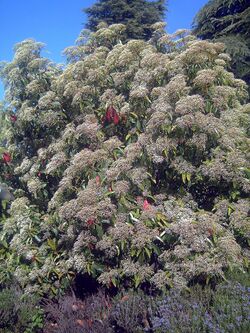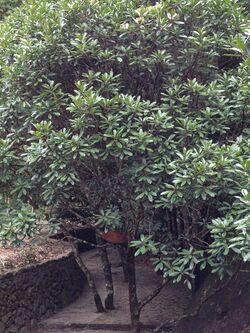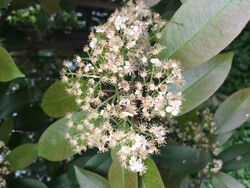Biology:Photinia serratifolia
| Photinia serratifolia | |
|---|---|

| |
| Scientific classification | |
| Kingdom: | Plantae |
| Clade: | Tracheophytes |
| Clade: | Angiosperms |
| Clade: | Eudicots |
| Clade: | Rosids |
| Order: | Rosales |
| Family: | Rosaceae |
| Genus: | Photinia |
| Species: | P. serratifolia
|
| Binomial name | |
| Photinia serratifolia (Desf.) Kalkman
| |
| Synonyms[1] | |
| |
Photinia serratifolia (syn. Photinia serrulata), commonly called Taiwanese photinia[2] or Chinese photinia is a flowering shrub or tree in the flowering plants family Rosaceae, found in mixed forests of China, Taiwan, Japan, the Philippines, Indonesia, and India.[3]
Description
The tree is evergreen, with white flowers emerging in spring accompanied by red-colored leaves, and red fruits growing in autumn. It grows typically 4–6 m (13–20 ft), sometimes up to 12 m (39 ft), tall.[3] Its leaves are toxic due to the presence of cyanogenic glycosides.[4] The flower, blossoming in spring, typically lasts for one to two weeks. Its flowers are known to have a strong scent similar to that of human semen. The flower have bell-shaped sepal split into five lobes, and around 20 stamens. Ovary contain two to four locules, with one ovule in each locule. The tree produces high amount of bright, red colored fruits that are small pomes with diameters ranging from 4–12 millimetres (0.16–0.47 inches), each containing one to four seeds. The fruit, ripen in autumn and survives through winter, is a food source to various kinds of birds, including thrushes, waxwings, and starlings. The seeds spread primarily through bird excretions.[3]
Distribution and habitat
The tree is typically found at altitudes from sea level to 2,500 metres (8,000 ft). It is found in mixed forests of central and southern China, Taiwan, Japan, the Philippines, Indonesia, and India.[3]
Varieties
Three varieties of the species are recognized in the Flora of China:[3][5]
- Photinia serratifolia var. ardisiifolia. Narrow leaf variant native to Taiwan, typically found around 850m altitude. Leaves are obovate (reverse ovate), ellipse-shaped, and leathery in texture.
- Photinia serratifolia var. daphniphylloides. Wide leaf variant native to Taiwan. Leaves are elliptic or long obovate.
- Photinia serratifolia var. lasiopetala. Native to Taiwan. Leaves are obovate, slender, or spoon-shaped.
Uses
The tree is widely used as a greening plant in some mainland Chinese cities, due to the relative ease to plant and maintain, and the tree being less demanding for its surrounding environments. In Wuhan, where the tree is in its native range, the tree is planted by the sides of all major avenues, as well as in the Wuhan University. However, due to the strong, semen-like odor from its flowers filling the entire city in spring, some Wuhan residents have complained that the tree should be removed and other trees should be planted instead.[6][7]
References
- ↑ {{citation | mode = cs1 | title = Photinia serratifolia | work = Germplasm Resources Information Network (GRIN) | url = | publisher = [[Organization:Agricultural Research ServAgricultural Research Service (ARS), United States Department of Agriculture (USDA) | access-date = 14 January 2018 }}
- ↑ "Photinia serratifolia". Natural Resources Conservation Service PLANTS Database. USDA. https://plants.usda.gov/core/profile?symbol=PHSE17.
- ↑ 3.0 3.1 3.2 3.3 3.4 Lu, Lingdi; Spongberg, Stephen A., Flora of China entry for Photinia serratifolia, 9, Missouri Botanical Garden & Harvard University Herbaria, p. 125, http://www.efloras.org/florataxon.aspx?flora_id=2&taxon_id=242337302, retrieved April 19, 2019
- ↑ K. A. Jacobs; F. S. Santamour Jr.; G. R. Johnson; M. A. Dirrs (September 1996). "Differential Resistance to Entomosporium Leafspot Disease and Hydrogen Cyanide Potential in Photinia" (PDF). J. Environ. Hort. 14 (3): 154–157. http://www.hriresearch.org/docs/publications/JEH/JEH_1996/JEH_1996_14_3/JEH%2014-3-154-157.pdf.
- ↑ "Photinia serratifolia". http://frps.iplant.cn/frps?id=Photinia%20serratifolia.
- ↑ "石楠花的委屈谁懂?专家:它是优秀的园林绿化物种(组图)_网易新闻". 2016-04-15. https://news.163.com/16/0415/17/BKN9OGS600014AEE.html.
- ↑ "武大石楠花气味怪 砍树?入药? 两不宜 - 长江商报官方网站". 2012-04-19. http://www.changjiangtimes.com/2012/04/385926.html.
Wikidata ☰ Q5220976 entry
 |



